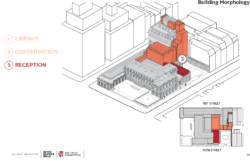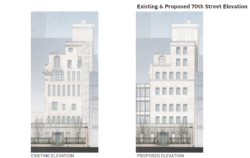
Additions schematic. Image credit: LPC.
After 2014 plan was withdrawn in face of public outcry, museum presented Selldorf-designed proposal to create more space for exhibitions, conservators, and educational programs. On May 29, 2018, the Landmarks Preservation Commission considered a proposal for the construction of rear and roof additions, as well as additional work, to the Frick Collection, an individual City landmark. The Frick was built as a mansion for industrialist Henry Clay Frick by the firm of Carrere and Hastings, and was converted to a museum displaying his art collection after his death. The building and its grounds stand at 895 Fifth Avenue on the Upper East Side of Manhattan.
In 2014, the museum presented a proposal for a 60,000-square-foot expansion that was withdrawn before reaching a Landmarks hearing after drawing public and political opprobrium. Objections to the plan focused on both its impact to the building and its impact on its gardens, designed by Russel Page.
At the hearing, Museum Director Ian Wardropper stated that as private house retrofitted into a public museum, the building had operational deficiencies the proposal intended to address. He noted that attendance had climbed steadily since the museum’s opening, seeing a tripling in attendance from 1935, from 100,000 annual visitors to approximately 300,000 today, and the museum required more space for a coatroom and bathrooms. Wardropper said that, contrary to public perception, the museum’s collection was not static, but had more than doubled since the museum’s inception. The museum currently displays approximately 30 percent of its holdings, and wished to exhibit more by converting the second floor, currently occupied by offices and not open to the public, to gallery space. He said the museum also desired improved space for its temporary exhibitions, which currently require the removal of otherwise permanently hanging art.
Wardropper said conservators currently worked in inadequate “cramped quarters” that required upgrading. Also, the museum currently has no dedicated educational space for the increasing amount of school groups it receives. The proposed work would also allow the museum to link its research library to its collection. He stated that the museum also wished to improve its facilities and manner of shipping and receiving art to and from other institutions. The project would also include improvements in accessibility for people with disabilities
Wardropper said the new plan would be “respectful of, and appropriate to, existing buildings,” and if the expansion were not allowed the building and the collection “risk being overwhelmed.”
Annabelle Selldorf, principal at Selldorf Architects, detailed the proposal, which would add 18,000 square feet to the institution. She noted that the museum seen multiple alterations and additions throughout its history.
Below grade, a new 220-seat auditorium would be constructed beneath the garden, where storage vaults currently exists. New elevator and stairways would be built for auditorium access. A cafe and store would be sited on the second floor. A new conservation studio would be built above the third-floor music room.

Library addition rendering. Image credit: LPC.
One addition would fill in a rear yard behind the museum, between the 70th Street garden and the library, and rise to seven stories, the height of the library, creating needed space and connecting the library to the museum. The addition will follow the lead of John Russell Pope’s design of the library in a contemporary manner, and be similarly clad in Indiana limestone and have bronze casement windows. A roof addition would be built above the museum’s music room, with the music room being converted to special exhibitions, creating a new connector between the museum and library buildings, and creating space for a conservation studio, administrative offices and a café vestibule. The music room’s current configuration would be lost in the alterations. This addition would also be clad in limestone with bronze windows and exterior solar shades. It would visually intermediate between the taller library and the museum.
The third addition would be built above the reception hall, and entail the redesign of the roof by slightly less than five feet. The addition would enable the creation of disabled access to the second floor galleries, and appear as a clerestory with bronze windows and a copper roof. A wheelchair ramp would also be built at the museum’s main entrance, necessitating alterations to the stairs and door.
If approved by Landmarks, the project will also require variance from the Board of Standards and Appeals, stated attorney for the applicants Valerie Campbell.
Landmarks counsel Mark Silberman clarified that the Frick’s interior was not designated, and the Commission’s purview only extended to external work.
The New York Landmarks Conservancy’s Andrea Goldwyn thanked the museum for listening to the public by retracting, rethinking, and scaling down their expansion plan. She said the current proposal was an appropriate intervention that furthered the institution’s mission without destroying historic fabric. Adam Roberts, representing the New York chapter of the American Institute of Architects, also supported the proposal for allowing the public to access the Frick’s second floors, while minimally impacting the exterior, with the additions appropriately integrating with the Beaux-Arts architecture. Area resident Judith Schneider said the proposal appropriately blended in with the museum and the “community surrounding it.” Frick Collection employees also read solicited letters of support into the record.
Friends of the Upper East Side Historic Districts’ Rachel Levy generally supported the “thoughtful approach” that successfully upheld the museum’s “jewel box qualities,” but asked the applicants to consider the feasibility of further reducing the addition over the music room, and lamented the music room’s loss. Tara Kelly, speaking for the Municipal Art Society, also said the proposal could be further improved, saying the additions to the library needed more texture and setbacks, and the addition to the reception hall would be better expressed as a skylight. Historic Districts Council Executive Director Simeon Bankoff said the proposal was “much more sympathetic” than the 2014 plan, but asked that the applicants consider ways in which they could advance their programmatic need without sacrificing the music room, a “wonderful interior space.” The Society for the Architecture of the City’s Christabel Gough also called the destruction of the music room an “irreplaceable loss to the people of the City.”
Martha Frick Symington Sanger, granddaughter of Henry Clay Frick, testified that the “still-over-the top architectural expansions” required further refinement, and objected to the removal of planters and the replacement of a blind lattice wall with a glass-faced addition. She said the “ultra-modern” design was inappropriate, and that office space could be moved off-site. Area resident Heidi Selig asked Landmarks to deny the proposal, stating Henry Clay Frick never envisioned a museum, but rather an “intimate house collection.” Upper East Side neighbor Miriam Klipper said the proposal failed to preserve the Frick’s architecture and integrity, and new space could be better sited off the property or underground.
Attorney Abraham Borenstein, representing a collection of opponents to the plan, testified that the Frick “works beautifully” as it is, and there was no rush to make decision on the matter. Borenstein said the “omnibus” proposal had many facets requiring deliberation. He said there was a great deal of scholarship in opposition to portions of the plan, and exhorted Landmarks not be rushed into making a hasty approval.
Chair Meenakshi Srinivasan stated that Community Board 8 split on the proposal and no resolution carried.
Wardropper responded to public testimony, contesting that the application was rushed, stating that the applicant had been working on the proposal for five years, and had explored all available alternatives, including attempting to purchase in an adjoining building. He said the proposal incorporated many ideas that had come from the community, including building the underground auditorium, and turning the music room into exhibition space. Selldorf said that the floor area that could be sited underground had been maximized in the proposal.
Commissioner Jeanne Lutfy said that “institutions evolve,” and it was important to allow museums to grow in their mission and further their service to constituents. She said she could approve the “restrained” proposal, and praised the applicants for working to address community concerns. Commissioner Anne Holford-Smith agreed, and said the museum was already somewhat of an amalgamation of accumulated additions and alterations, and the property was robust enough to sustain an addition. Commissioner Adi Shamir-Baron also embraced the proposal as “incremental” and “responsible,” and said they would not negatively impact the visitor experience of the museum.
Commissioner Michael Devonshire said the proposal was not yet where he could vote to approve it, and it could be further reduced to prevent it turning from a “collection” to a “colossus.” He argued that a café was unnecessary, and he would prefer to see the conservator workroom built below-grade. Though he acknowledged it was outside of Landmarks regulatory authority, he said the destruction of the music room “doesn’t sit right with me.”
Chair Srinivasan commended the applicants for layering the additions and setting them away from the street to minimize their visual impact. She asked the applicants to return to Landmarks at another time to further address public and Commissioner comments.
LPC: The Frick Collection, 1 East 70th Street, Manhattan (LPC-19-25099) (May 29, 2017) (Architects: Selldorf Architects, Beyer Blinder Belle).
By: Jesse Denno (Jesse is a full-time writer and staff.)

